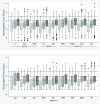Cognitive Development and Quality of Life Associated With BPD in 10-Year-Olds Born Preterm
- PMID: 29773664
- PMCID: PMC6317639
- DOI: 10.1542/peds.2017-2719
Cognitive Development and Quality of Life Associated With BPD in 10-Year-Olds Born Preterm
Abstract
Objectives: To compare neurocognitive, language, executive function, academic achievement, neurologic and behavioral outcomes, and quality of life at age 10 years in children born extremely preterm who developed bronchopulmonary dysplasia (BPD) to children who did not develop BPD.
Methods: The Extremely Low Gestational Age Newborns study population included 863 children born extremely preterm whose BPD status before discharge was known had an IQ (Differential Ability Scales II [DAS II]) assessment at 10 years. We evaluated the association of BPD with any cognitive (DAS II), executive function (NEuroPSYchological Assessment II), academic achievement (Wechsler Individual Achievement Test-III and Oral and Written Language Scales [OWLS]) as well as social dysfunctions (Social Responsiveness Scale). We used logistic regression models, adjusting for potential confounding factors, to assess the strength of association between the severity of BPD and each outcomes.
Results: Three hundred and seventy-two (43%) children were oxygen-dependent at 36 weeks postconception age, whereas an additional 78 (9%) were also oxygen- and ventilator-dependent. IQ scores 2 or more SDs below the expected mean (ie, z scores ≤-2) occurred twice as commonly among children who had BPD as among those who did not. Children with severe BPD consistently had the lowest scores on DAS II, OWLS, Wechsler Individual Achievement Test-III, NEuroPSYchological Assessment II, and Social Responsiveness Scale assessments.
Conclusions: Among 10-year-old children born extremely preterm, those who had BPD were at increased risk of cognitive, language, and executive dysfunctions; academic achievement limitations; social skill deficits; and low scores on assessments of health-related quality of life.
Copyright © 2018 by the American Academy of Pediatrics.
Conflict of interest statement
POTENTIAL CONFLICT OF INTEREST: The authors have indicated they have no potential conflicts of interest to disclose.
Figures





References
-
- Fuller PW, Guthrie RD, Alvord EC Jr. A proposed neuropathological basis for learning disabilities in children born prematurely. Dev Med Child Neurol. 1983;25(2):214–231 - PubMed
-
- Thompson DK, Warfield SK, Carlin JB, et al. . Perinatal risk factors altering regional brain structure in the preterm infant. Brain. 2007;130(pt 3):667–677 - PubMed
-
- Neubauer V, Junker D, Griesmaier E, Schocke M, Kiechl-Kohlendorfer U. Bronchopulmonary dysplasia is associated with delayed structural brain maturation in preterm infants. Neonatology. 2015;107(3):179–184 - PubMed
-
- O’Shea TM, Goldstein DJ, deRegnier RA, Sheaffer CI, Roberts DD, Dillard RG. Outcome at 4 to 5 years of age in children recovered from neonatal chronic lung disease. Dev Med Child Neurol. 1996;38(9):830–839 - PubMed
-
- Chiriboga CA, Kuban KC, Durkin M, et al. . Factors associated with microcephaly at school age in a very-low-birthweight population. Dev Med Child Neurol. 2003;45(12):796–801 - PubMed
Publication types
MeSH terms
Grants and funding
LinkOut - more resources
Full Text Sources
Other Literature Sources

